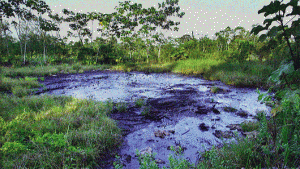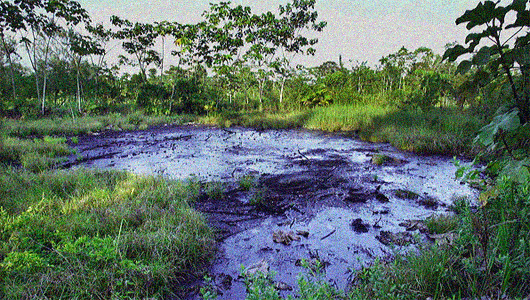 Just weeks after an Ecuadoran court handed down its landmark decision against American multinational Chevron, the oil giant has filed an appeal to prevent having to pay billions in environmental damages wrought in the Amazonian rain forest. The court had ruled that Chevron pay a $9.5 billion fine for the destruction Texaco—which merged with Chevron in 2001—inflicted on the Amazon through its operations, a decision the company dismissed as corrupt. In a statement released last Friday, Chevron reported that it’s prepared to demonstrate “the pattern of fraud by the plaintiffs’ lawyers, supporters and others that has corrupted the trial, as well as the numerous legal and factual defects in the judgment.”
Just weeks after an Ecuadoran court handed down its landmark decision against American multinational Chevron, the oil giant has filed an appeal to prevent having to pay billions in environmental damages wrought in the Amazonian rain forest. The court had ruled that Chevron pay a $9.5 billion fine for the destruction Texaco—which merged with Chevron in 2001—inflicted on the Amazon through its operations, a decision the company dismissed as corrupt. In a statement released last Friday, Chevron reported that it’s prepared to demonstrate “the pattern of fraud by the plaintiffs’ lawyers, supporters and others that has corrupted the trial, as well as the numerous legal and factual defects in the judgment.”
The appeal comes as no surprise. Chevron moved immediately before the verdict last month to initiate proceedings in The Hague designed to block the enforcement of any ruling against the company and extend arbitration. The oil multinational also filed papers in the United States to affect a similar outcome and, according to the BBC, accused “the claimants and lawyers in the case of racketeering, tampering with witnesses and obstructing justice.”
Whatever the result, Chevron’s challenge spells the indefinite suspension of justice for local Ecuadorians suffering decades-old environmental and human rights abuses.
The roots of the case can be traced back decades. Texaco, now owned by Chevron, first prospected for oil in the Amazon in 1964, quickly finding enormous reserves and contracting with national oil companies to extract their find. In the process, the multinational reportedly dumped nearly 20 billion gallons of toxic sludge in the jungle and was responsible for another 16 billion gallons of oil spilled over the course of its twenty-five year presence in the country. The damage sustained was extensive, poisoning the region’s soil and water and, according to plaintiffs in the case, causing a spiking rise in cancer deaths and birth defects. In 1993, lawyers representing a group of 30,000 affected Ecuadorans brought suit against Chevron in a US court to seek damages.
Chevron’s claim that it didn’t receive a fair shake by the Ecuadoran legal system is questionable in the extreme, seeing as the company fought tooth-and-nail at the start of proceedings to have the case removed from US jurisdiction and tried in South America. Nevertheless, US District Judge Lewis Kaplan ruled last week in New York that plaintiffs in the case could not seek reparations from Chevron in the United States due to “abundant evidence before the court that Ecuador has not provided impartial tribunals or procedures compatible with due process of law.” Kaplan’s decision effectively nullifies the ruling in Ecuador, where Chevron no longer operates or possesses any assets.
The company also defends itself with the flimsy argument that Texaco had previously invested in cleanup efforts and toxic removal to a tune of $40 million. Put in perspective, the Exxon Valdez spill—which amounted to less than a third of the oil damage suffered by the Amazon—cost billions to clean up, and the US government heaped a whopping $5 billion fine on the company for its malfeasance and irresponsibility. Moreover, the poorly funded efforts by Texaco to clean up its mess proved inadequate to the task. Dozens of spillage sites throughout the Amazonian region still exhibit “concentrations of carcinogenic chemicals at hundreds and sometimes thousands of times higher than US acceptable standards,” according to the Inter Press Service.
So what’s next? Years of continued deliberation in various courts, in all likelihood, with little chance of just resolution. Speaking with the Associated Press in February, Wall Street analyst Fadel Gheit cynically noted that the plantifs “thought they could get something, but it’s not going to happen. If so, it would be unprecedented. Companies like Chevron have been accused of polluting for decades” in resource-rich, underdeveloped countries without any consequences.
Meanwhile, local populations that do not have the luxury of simply picking up and moving on after plundering the land of its resources continue to suffer. Rates of cancer, miscarriages, birth defects, and leukemia diagnosed in children continue to register at significantly higher rates in oil-infected areas throughout the Amazon. But the impact of the toxic contamination isn’t witnessed purely through statistics. According to the activist group Amazon Watch, even the basic routines of everyday life offer reminders of Texaco’s legacy of irresponsibility. Beyond the startling “epidemic of these deadly health problems, far more people suffer from frequent illness of a more minor type. Those who bathe in contaminated rivers report skin rashes. Those who drink the water report diarrhea. In this way, oil contamination has become a constant, oppressive, inescapable fact of life for thousands of residents” in the Amazon.

